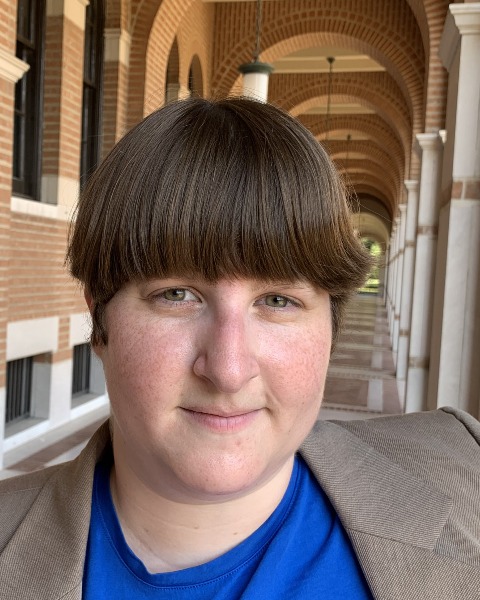Nano and Micro Technologies
Microfluidics for Cellular Analysis
Microscale measurement of protein complexes from single cancer cells
Thursday, October 24, 2024
9:00 AM - 9:15 AM EST
Location: Room 316

Julea Vlassakis, PhD (she/her/hers)
Assistant Professor of Bioengineering
Rice University
Houston, Texas, United States
Edgar Ruiz Bello (he/him/his)
Rice University, United States
Presenting Author(s)
Co-Author(s)
Introduction: Micro-scale separation systems are well-suited for achieving high-selectivity separations of proteins from minute quantities of analyte. However, when the analytes of interest are dynamic protein complexes, micro-channel, and capillary electrophoresis still struggle to achieve separations without destroying protein complexes, for example, by Joule heating-based dissociation of the complexes. We previously partially addressed these challenges by introducing single-cell protein interaction fractionation through electrophoresis and immunoassay readout (SIFTER). With SIFTER we simultaneously fractionated cytoskeletal protein complexes from monomeric proteins in hundreds of single cells in an open micro-scale electrophoresis assay. Yet, SIFTER fractionation precludes the identification of subunit stoichiometry and abundance of individual protein complexes. Such quantification is needed to determine protein complex therapeutic targets in cancer cell subpopulations (i.e., drug-resistant tumor cells). Here, we describe high-throughput multi-dimensional open micro-scale electrophoresis systems for protein complexes designed for single-cell analysis.
Materials and
Methods: We fabricate a gel array on a microscope slide cut in half and silanized with 3-(Trimethoxysilyl)propyl methacrylate (ThermoFisher Scientific). A 30 𝜇𝑚 polyacrylamide gel is cast by sandwiching 14%T polyacrylamide gel precursor solution with 1X Tris Glycine, 3 mM benzophenone methacrylamide (Raybow), 0.08% vol/vol APS and 0.08% vol/vol TEMED between the silanized glass and an SU8 micropost array. Hydrogel lids (500 μm thick) comprised of 15% T polyacrylamide are fabricated to cover the half slide and span the electrodes of a custom 3D printed electrophoresis chamber.
For slab gel electrophoresis, 𝛽 – Phycoerythrin (AnaSpec, ThermoFisher Scientific) was electrophoretically separated in a 14%T gel cassette (ThermoFisher Scientific) run at 28.1 V/cm for 50 min using the Xcell surelock Mini-cell Invitrogen chamber.
For microscale two-dimensional separation of 𝛽 – Phycoerythrin, 50 – 100 𝜇𝐿 of 0.2 – 1 mg/mL protein solution, with 10% glycerol was added to the microwell gel surface and incubated for 5 minutes, and excess was removed. A gel lid with 2X tris glycine running buffer (diluted from 10x, pH = 8.3, BioRad) interfaces between the gel surface and electrodes of the 3D printed chamber. Native electrophoresis is performed for 10 minutes at 29.2 V/cm prior to in-gel denaturation (0.5× Tris-glycine, 0.5% SDS, 0.25% sodium deoxycholate, 0.1% Triton X-100, 8 M urea, pH = 8.3) at 95°C for 5 minutes. SDS-PAGE is performed for 4 minutes at 31.9 V/cm. Fluorescently labeled protein is imaged using a fluorescence microarray scanner (Genepix 4300, Molecular Devices, 800 PMT and 90% power).
Results, Conclusions, and Discussions: To separate protein complex subunits, we select electrophoresis device length scales and buffer chemistries to maintain protein complexes during native electrophoresis and minimize diffusive loss of proteins out of the open microfluidic device. Protein complexes are natively separated first by size/charge before in-gel denaturation and separation of subunits in the orthogonal direction in the multi-dimensional separation assay. The assay takes place within the SIFTER open microfluidic polyacrylamide gel with an array of microwells (30 μm in diameter) for single-cell settling or (100 μm in diameter) purified protein deposition and buffer delivery with a hydrogel lid (Figure 1). An estimate of the diffusive timescale, τ, of native protein complexes out of the ~40 µm-tall gel during electrophoresis is τ ~93.8 minutes for 240 kDa β-Phycoerythrin in a 14 %T gel (assuming a protein hydrodynamic radius of R-Phycoerythrin, a structurally similar and same-sized protein complex). Thus, native separations can be performed for 10s of minutes, as needed, without appreciable analyte loss from the open microdevice. Following the native separation, in-gel denaturation, and SDS polyacrylamide gel electrophoresis (PAGE), proteins are directly imaged or covalently immobilized to the gel and immunoprobed to quantify relative levels of protein subunits.
For proof-of-concept, we separate purified β-Phycoerythrin, which is composed of α, β, and γ subunits (17.5, 18.5, and 30.2 kDa, respectively) in an (αβ)6γ structure. Bulk SDS PAGE in a 14% T gel separates the and γ subunit from a band comprised of the α and β subunits (Figure 2). Conducting the microscale 2D electrophoretic assay with purified β-Phycoerythrin, we observe injection of the native protein complex as a single band. Upon in-gel denaturation and orthogonal electrophoresis, two protein bands are separated. Across the array, we quantify the separation resolution Rs = 2.08 ± 0.40, n = 32 separations across one device. Thus, protein complex subunits are baseline resolved in the microscale 2D separation.
We are applying the 2D assay to measure multicomponent chaperone protein complexes in single Ewing sarcoma cancer cells. We anticipate our assay can assess protein-complex makeup in heterogeneous cell populations across biological contexts.
Acknowledgements (Optional): Acknowledgment: The Burroughs Wellcome Fund Career Award at the Scientific Interface supported the work presented here.
